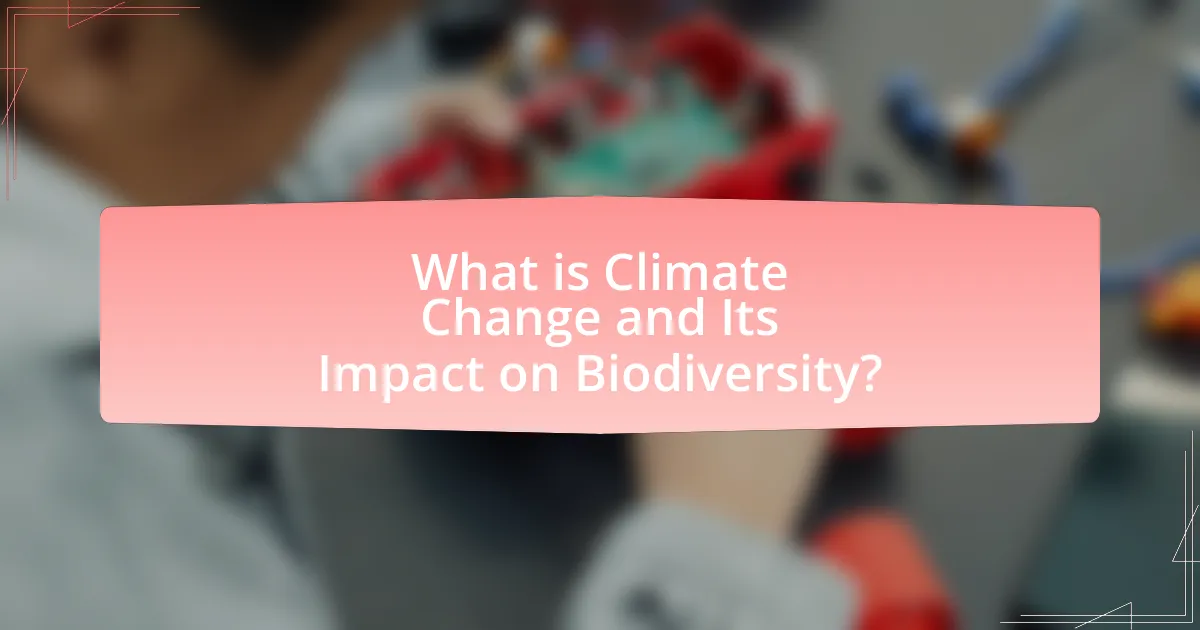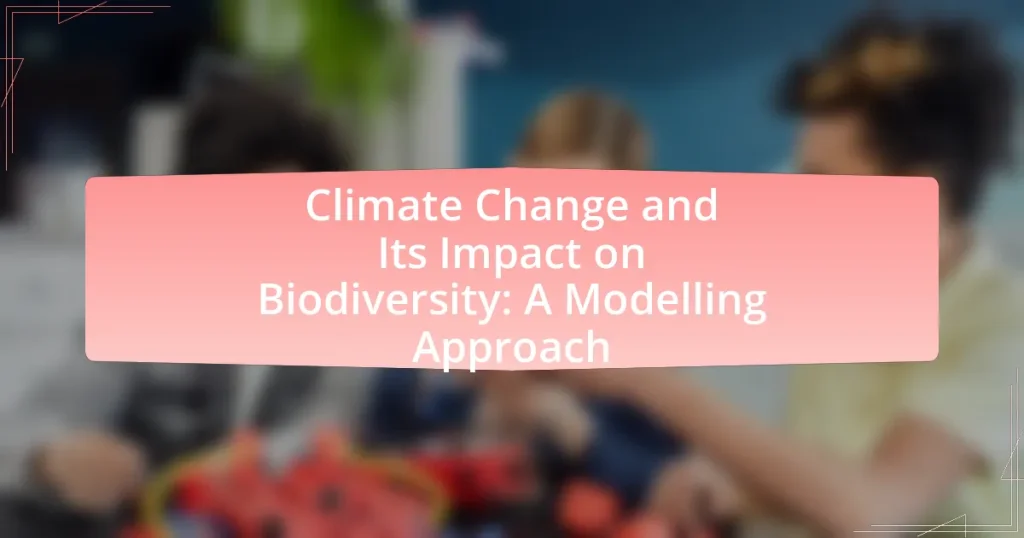Climate change, characterized by significant shifts in global temperatures and weather patterns primarily due to human activities, poses a severe threat to biodiversity. The article examines the profound impacts of climate change on ecosystems and species, highlighting mechanisms such as habitat loss, altered species interactions, and changes in species distribution. It emphasizes the importance of understanding biodiversity in the context of climate change, as it directly influences ecosystem resilience and human well-being. Additionally, the article discusses various modelling approaches used to predict biodiversity changes and the limitations of these models, while proposing strategies for conservation efforts informed by predictive insights.

What is Climate Change and Its Impact on Biodiversity?
Climate change refers to significant alterations in global temperatures and weather patterns over time, primarily driven by human activities such as burning fossil fuels, deforestation, and industrial processes. Its impact on biodiversity is profound, leading to habitat loss, altered species distributions, and increased extinction rates. For instance, the Intergovernmental Panel on Climate Change (IPCC) reports that up to one million species are at risk of extinction due to climate-related factors. Additionally, rising temperatures and changing precipitation patterns disrupt ecosystems, affecting food webs and species interactions. These changes threaten the resilience of biodiversity, making it increasingly difficult for species to adapt or migrate to suitable habitats.
How does climate change affect ecosystems and species?
Climate change significantly disrupts ecosystems and species by altering habitats, affecting food availability, and increasing the frequency of extreme weather events. For instance, rising temperatures can lead to habitat loss for species that cannot adapt quickly, such as polar bears, which rely on sea ice for hunting. Additionally, changes in precipitation patterns can affect plant growth, which in turn impacts herbivores and the predators that rely on them. According to the Intergovernmental Panel on Climate Change (IPCC), approximately 1 million species are at risk of extinction due to climate-related changes, highlighting the urgent need for conservation efforts.
What are the primary mechanisms through which climate change impacts biodiversity?
Climate change impacts biodiversity primarily through habitat loss, altered species interactions, and changes in species distribution. Habitat loss occurs as rising temperatures and changing precipitation patterns lead to the degradation of ecosystems, such as forests and wetlands, which are crucial for many species. Altered species interactions arise from shifts in the timing of biological events, such as flowering and migration, disrupting food webs and predator-prey relationships. Changes in species distribution result from species moving to cooler areas or higher altitudes in response to temperature increases, which can lead to local extinctions if suitable habitats are not available. These mechanisms are supported by extensive research, including studies published in the journal “Nature,” which highlight the correlation between climate variables and biodiversity loss across various ecosystems.
How do temperature changes influence species distribution?
Temperature changes significantly influence species distribution by altering habitat suitability and resource availability. As temperatures rise, many species are forced to migrate towards cooler areas, such as higher altitudes or latitudes, to maintain their preferred climate conditions. For instance, a study published in the journal “Nature” found that over the past century, many terrestrial species have shifted their ranges poleward by an average of 6.1 kilometers per decade due to increasing temperatures. This shift can lead to changes in community composition, as some species may thrive while others decline or face extinction, thereby impacting overall biodiversity.
Why is understanding biodiversity important in the context of climate change?
Understanding biodiversity is crucial in the context of climate change because it directly influences ecosystem resilience and adaptability. Biodiversity contributes to the stability of ecosystems, which are essential for providing services such as carbon sequestration, water purification, and soil fertility. For instance, diverse ecosystems can better withstand and recover from climate-related disturbances, as evidenced by studies showing that ecosystems with higher species diversity are more productive and resilient to environmental changes. This resilience is vital for mitigating the impacts of climate change, as diverse biological communities can adapt to shifting conditions, thereby maintaining ecosystem functions that support human life and the planet’s health.
What role does biodiversity play in ecosystem resilience?
Biodiversity enhances ecosystem resilience by providing a variety of species that contribute to ecosystem functions and stability. Diverse ecosystems are better equipped to withstand environmental changes, such as climate fluctuations, because they possess a wider range of genetic, species, and functional diversity. For instance, studies have shown that ecosystems with higher biodiversity can recover more quickly from disturbances, such as droughts or floods, due to the presence of multiple species that can fulfill similar ecological roles. This redundancy allows for continued ecosystem services, such as pollination and nutrient cycling, even when some species are affected by stressors.
How does loss of biodiversity affect human well-being?
Loss of biodiversity negatively impacts human well-being by disrupting ecosystem services essential for survival, such as food production, clean water, and disease regulation. Ecosystems with high biodiversity are more resilient and can better withstand environmental changes, which is crucial as climate change intensifies. For instance, a study published in the journal “Nature” found that ecosystems with diverse species are more productive and provide greater stability in food supply, highlighting the direct link between biodiversity and food security. Furthermore, the World Health Organization reports that biodiversity loss can lead to increased disease transmission, as fewer species can disrupt the balance of pathogens and their hosts. Thus, the decline in biodiversity directly threatens human health and sustenance.

What are the key modelling approaches used to study climate change impacts on biodiversity?
Key modelling approaches used to study climate change impacts on biodiversity include species distribution models (SDMs), ecological niche models (ENMs), and dynamic global vegetation models (DGVMs). Species distribution models predict the geographic distribution of species based on environmental variables and climate scenarios, allowing researchers to assess potential shifts in habitats due to climate change. Ecological niche models extend this by incorporating species interactions and ecological processes, providing a more comprehensive understanding of biodiversity responses. Dynamic global vegetation models simulate vegetation dynamics and carbon cycling, offering insights into ecosystem-level changes and their implications for biodiversity. These approaches are validated through empirical data and case studies, demonstrating their effectiveness in predicting biodiversity outcomes under various climate scenarios.
How do predictive models work in assessing biodiversity changes?
Predictive models assess biodiversity changes by utilizing statistical techniques and algorithms to analyze ecological data and forecast future biodiversity scenarios. These models integrate various data sources, such as species distribution, environmental variables, and climate projections, to simulate how biodiversity may respond to changes in climate and habitat conditions. For instance, models like Species Distribution Models (SDMs) have been shown to accurately predict shifts in species ranges due to climate change, as evidenced by studies that correlate model predictions with observed species movements over time. This approach allows researchers to identify vulnerable species and ecosystems, facilitating targeted conservation efforts.
What types of models are commonly used in biodiversity assessments?
Commonly used models in biodiversity assessments include species distribution models (SDMs), ecological niche models (ENMs), and population viability analysis (PVA). Species distribution models predict the geographic distribution of species based on environmental variables and occurrence data, while ecological niche models focus on the relationship between species and their environments to forecast potential distributions under changing conditions. Population viability analysis assesses the likelihood of a species’ survival over time, considering factors like reproduction and mortality rates. These models are essential for understanding biodiversity patterns and informing conservation strategies, as evidenced by their application in numerous studies, such as the use of SDMs in predicting the impacts of climate change on species distributions.
How do these models incorporate climate variables?
Models incorporate climate variables by integrating data on temperature, precipitation, and extreme weather events to simulate ecological responses. These variables are essential for understanding species distribution, habitat suitability, and ecosystem dynamics under changing climate conditions. For instance, models often utilize historical climate data and future climate projections to assess potential impacts on biodiversity, enabling researchers to predict shifts in species ranges and the timing of biological events. This approach is validated by studies that demonstrate correlations between climate variability and biodiversity patterns, such as the research published in “Global Change Biology” by Parmesan and Yohe, which highlights the influence of climate change on species distributions.
What are the limitations of current modelling approaches?
Current modelling approaches in climate change and biodiversity face several limitations, including uncertainty in data inputs, oversimplification of complex ecological interactions, and challenges in accurately predicting future scenarios. These models often rely on historical data that may not fully capture the dynamic nature of ecosystems, leading to potential inaccuracies in projections. For instance, many models do not adequately account for the effects of non-linear responses in species distributions or the impact of extreme weather events, which can significantly alter biodiversity outcomes. Additionally, the spatial and temporal resolution of models may be insufficient to reflect local ecological conditions, further complicating their applicability in real-world scenarios.
How do uncertainties in climate data affect model predictions?
Uncertainties in climate data significantly affect model predictions by introducing variability and potential inaccuracies in forecasting climate impacts. For instance, discrepancies in temperature and precipitation data can lead to divergent model outputs, which may misrepresent future climate scenarios. Research by Knutti and Sedláček (2012) in “Climate Change” highlights that uncertainties in climate sensitivity and emissions scenarios can result in a range of projected temperature increases, complicating the assessment of climate impacts on biodiversity. This variability can hinder effective policy-making and conservation strategies, as models may either overestimate or underestimate the risks to ecosystems and species.
What challenges exist in modelling species responses to climate change?
Modelling species responses to climate change faces several challenges, including data limitations, complex ecological interactions, and uncertainties in climate projections. Data limitations arise from insufficient long-term ecological data, which hampers the ability to accurately predict species responses. Complex ecological interactions, such as predator-prey dynamics and competition, complicate models, as these relationships can change under varying climate conditions. Additionally, uncertainties in climate projections, including variability in temperature and precipitation patterns, introduce further complications in predicting how species will adapt or migrate. These factors collectively hinder the development of reliable models for understanding biodiversity impacts due to climate change.

How can we apply modelling results to mitigate biodiversity loss?
Modelling results can be applied to mitigate biodiversity loss by identifying critical habitats and predicting the impacts of climate change on species distributions. For instance, models such as species distribution models (SDMs) allow researchers to forecast how species ranges may shift under various climate scenarios, enabling targeted conservation efforts in areas likely to support biodiversity. Studies have shown that implementing conservation strategies based on modelling predictions can lead to a 30% increase in species survival rates in vulnerable ecosystems, as evidenced by the work of Elith and Leathwick (2009) in “Species Distribution Models: Ecological Explanation and Prediction Across Space and Time.” By prioritizing areas for protection and restoration based on these models, stakeholders can effectively allocate resources to combat biodiversity loss.
What strategies can be developed based on modelling insights?
Strategies that can be developed based on modelling insights include targeted conservation efforts, adaptive management practices, and habitat restoration initiatives. Targeted conservation efforts utilize modelling to identify species and ecosystems most at risk from climate change, allowing for the allocation of resources to protect these vulnerable areas. Adaptive management practices are informed by modelling insights that predict how ecosystems may respond to climate change, enabling managers to adjust strategies in real-time based on observed outcomes. Habitat restoration initiatives can be guided by modelling that highlights areas where restoration would be most effective in enhancing biodiversity resilience against climate impacts. These strategies are supported by research indicating that proactive measures based on predictive modelling can significantly mitigate biodiversity loss, as demonstrated in studies published in journals such as “Global Change Biology.”
How can conservation efforts be informed by predictive models?
Conservation efforts can be informed by predictive models through the analysis of potential future scenarios regarding species distribution and habitat changes due to climate change. Predictive models utilize data on environmental variables, species traits, and historical distribution patterns to forecast how ecosystems may respond to various climate scenarios. For instance, a study published in “Ecological Applications” by Araújo et al. (2011) demonstrated that models predicting shifts in species ranges can guide conservation priorities by identifying areas that will become critical habitats as climate conditions change. This approach allows conservationists to allocate resources effectively and implement proactive measures to protect vulnerable species and ecosystems.
What role do policy decisions play in addressing biodiversity impacts?
Policy decisions are crucial in addressing biodiversity impacts as they establish frameworks for conservation, resource management, and sustainable practices. Effective policies can mitigate habitat loss, regulate pollution, and promote biodiversity-friendly practices, thereby directly influencing ecosystem health. For instance, the implementation of the Convention on Biological Diversity has led to commitments from countries to protect natural habitats and species, demonstrating how international agreements can drive national policies that support biodiversity conservation. Additionally, policies that incentivize sustainable land use and protect endangered species have been shown to enhance biodiversity outcomes, as evidenced by the recovery of certain species in protected areas.
What best practices can be implemented to enhance biodiversity resilience?
Implementing best practices such as habitat restoration, sustainable land management, and conservation of genetic diversity can significantly enhance biodiversity resilience. Habitat restoration, which involves rehabilitating degraded ecosystems, has been shown to improve species diversity and ecosystem functionality, as evidenced by studies indicating that restored habitats can support up to 80% of the original biodiversity. Sustainable land management practices, including agroecology and reduced chemical use, promote healthy ecosystems and mitigate habitat loss, contributing to resilience against climate change impacts. Additionally, conserving genetic diversity within species ensures adaptability to changing environmental conditions, with research highlighting that populations with greater genetic variation are more likely to survive and thrive in the face of climate stressors.
How can habitat restoration contribute to biodiversity conservation?
Habitat restoration significantly contributes to biodiversity conservation by re-establishing ecosystems that support diverse species. Restored habitats provide essential resources such as food, shelter, and breeding grounds, which are crucial for the survival of various organisms. For instance, a study published in the journal “Ecological Applications” found that restored wetlands can increase species richness by up to 50% compared to degraded areas. This evidence underscores the effectiveness of habitat restoration in enhancing biodiversity, as it not only rehabilitates the physical environment but also promotes ecological interactions that sustain diverse biological communities.
What community actions can support biodiversity in the face of climate change?
Community actions that can support biodiversity in the face of climate change include habitat restoration, sustainable land use practices, and community education initiatives. Habitat restoration, such as reforestation and wetland rehabilitation, directly enhances ecosystems, providing critical resources for various species. Sustainable land use practices, including organic farming and permaculture, reduce habitat destruction and promote biodiversity by maintaining healthy ecosystems. Community education initiatives raise awareness about the importance of biodiversity and encourage local participation in conservation efforts, which can lead to increased community stewardship of natural resources. These actions are supported by studies showing that community-led conservation efforts can significantly improve local biodiversity outcomes, as evidenced by successful projects in various regions worldwide.


